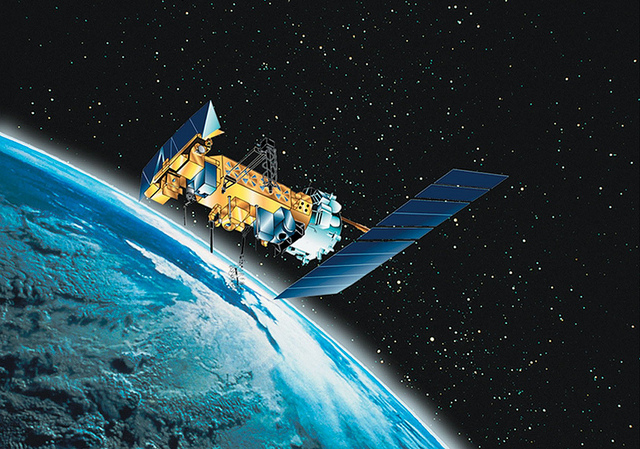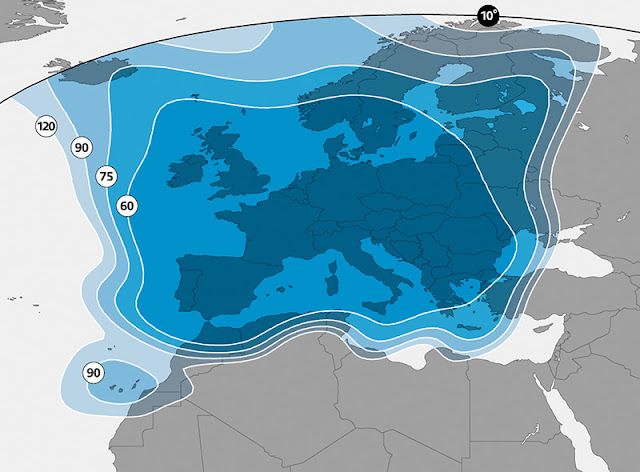Satellite Astra 19.2 ° E
Satellite Astra 19.2 ° E,
SES is the name given by SES of Bitzdorf, Luxembourg,
to the Astra constellation of
communications satellites located at the 19.2° East orbital position in the
Clark Belt.
SES
is the owner of the Astra 19.2°E, which is traditionally called the Astra 1,
and it is also the operator.
It was the first orbital position used by Astra and the craft there are all named Astra 1x.
This
was changed by SES to Astra 19.2°E in 2008, to avoid confusion with Astra's
other orbital locations.
Those locations now include the Astra 1x, which was originally positioned at 19.2°E.
At
19.2° east, the Astra satellites provide link services in the 10.70 GHz - 12.70
GHz band of the K u band.
Astra
19.2°E is one of the major TV satellite sites serving Europe.
It
transmits over 1,150 television, radio and interactive channels to over 93
million direct to home (DTH) and cable homes in 35 countries.
Other major satellite positions are also in orbits, 13°E, 28.2°E, 23.5°E and 5°E.
Satellite Astra 19.2 ° E
There
are more than 40 HDTV channels broadcast via satellite at 19.2°E, using five
HDTV platforms.
SES
was also instrumental in introducing high-definition satellite television into
Europe, using the Astra 19.2°E satellites.
It
helped create HD-ready specifications for TVs to display HDTV broadcasts.
HD+,
a subsidiary of SES, operates the free HD+ platform for German channels from
Astra 19.2°E.
Astra 19.2 ° E
It
is one of the last satellite sites to carry many analog channels, until 30
April 2012 when the German analogue shutdown was completed.
It
is also the only site that has carried radio stations in the private Astra
Digital Radio format, although this technology has been superseded by DVB-S
Radio.
As
analogue transceivers that transfer service to digital.
The
Astra 19.2°E satellites primarily provide digital television, digital radio and
multimedia services to Europe and North Africa.
Mainly
to Algeria, Austria, Belgium, France, Germany, Morocco, Netherlands, Poland,
Spain, Switzerland and Tunisia
Astra 19.2°E provides both free-to-air television and a number of pay-TV services in networks such as ARD Digital,
ArenaSat, CanalDigitaal, CanalSat, ORF Digital,
Sky Germany, ProSieben, Movistar +, Sat1, UPC Direct and ZDF.
It is also the market leader for DTH receivers and group plates in Austria,
Belgium, France, Germany, the Netherlands, Spain and Switzerland.
Astra's
relatively close proximity to 19.2°E also allows for one of the other SES
orbital locations, Astra 23.5°E.
This is done using a single small dish in the target countries,
which is equipped
with a Duo LNB monoblock array to receive channels from both locations.
Launch Astra 1A
Launched
in 1988, the Astra 1A was the first satellite in the Astra range of 19.2°E, and
with 16 transponders, the Astra 1A was the first satellite dedicated to
receiving DTH for satellite television across Europe.
Since the start of transmission in 1989, the Astra 1A has carried four channels of Sky Television plc,
the world's first multi-channel commercial DTH service, on
leased transceivers before the satellite was completed.
Early
channels broadcasting from 19.2° East included those intended primarily for the
United Kingdom, Germany, the Benelux, and Scandinavia.
And
the so-called European channels such as MTV Europe, CNN International and
Eurosport.
In 1991 Astra 1A was joined at 19.2°E by Astra 1B, and later by Astra 1C in 1993,
in order to establish the SES principles of satellite positioning to provide a
transparent backup of each satellite to others in the group.
The
first three Astra 19.2°E satellites also carried analog channels only in PAL
and D2-MAC.
Satellite Astra 1D
It
is the fourth satellite, launched in 1994, originally intended to carry the
first European digital TV channels.
But
the rapid expansion of satellite television across Europe and the demand for
analog television capacity meant that it was used primarily for analog signals.
In
1995, the Astra 1E was dedicated to digital satellite television broadcasting
services for Europe.
Subsequent
satellites launched to the Astra 19.2°E were also fully digital in their
traffic.
Satellite Astra 19.2 ° E
In
addition to the digital transmission of satellite television, came the shift to
coding and targeting of channels to individual countries or regions.
The
demand for digital TV capacity was so great that SES opened additional orbital
locations to provide new digital networks targeting specific countries.
Starting with Astra 28.2°E for the United Kingdom and Ireland, in 1998,
it also became
the home of Sky Digital, and the last Sky analog channels left Astra 19.2°E in
2001.
Most
Scandinavian broadcasters also migrated from Astra 19.2°E to 1°West and Astra
5°E.
Then SES also opened orbital positions for Astra 23.5°E and Astra 31.5°E to handle ever-
increasing demands for digital capacity and expand the markets of Eastern Europe,
Africa and Asia now served by Astra satellites.
And
in November last year, SES ordered two replacement satellites from Thales
Alenia Space for launch to Astra 19.2°E in 2024.
With the Astra 1KR and Astra 1L reaching the end of their planned life,
the Astra 1P will also bring live TV home to Europe, particularly Germany, France and Spain.
You may like: EUTELSAT 16A satellite
















cvp serveur gratuit ......
ReplyDelete